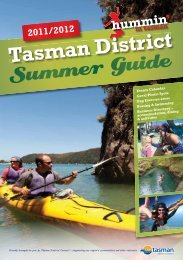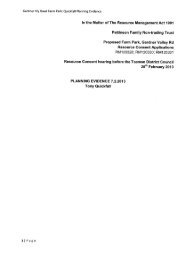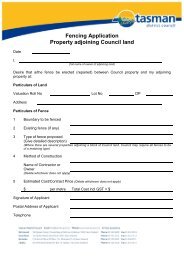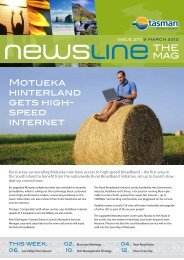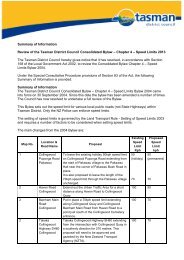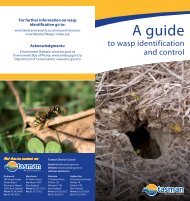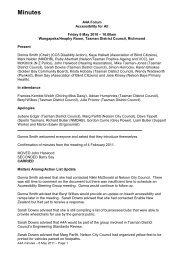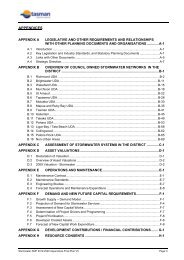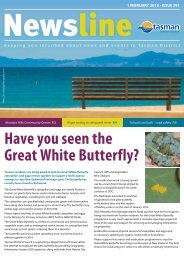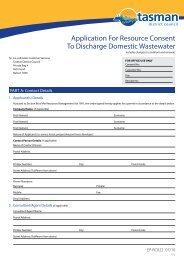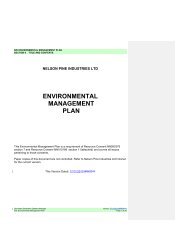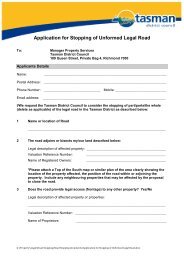Abel Tasman Foreshore Scenic Reserve Draft Management Plan
Abel Tasman Foreshore Scenic Reserve Draft Management Plan
Abel Tasman Foreshore Scenic Reserve Draft Management Plan
You also want an ePaper? Increase the reach of your titles
YUMPU automatically turns print PDFs into web optimized ePapers that Google loves.
and foreshore habitats are restored with each tide or storm. On exposed rocky<br />
shores, the effects of wave action and tides limit the habitat to hardy species which<br />
are resilient to disturbance. On sheltered soft shores, within estuaries, species and<br />
habitats are vulnerable to disturbance and depletion, despite the effects of regular<br />
exposure and inundation by the tides and the dynamic nature of the estuarine<br />
ecosystem. The connections between all these ecosystems need to be recognised.<br />
Restoration is largely restricted to those species with national recovery plans, such as<br />
coastal cresses and some bird species. For the great majority of species it is not<br />
practical to address their needs directly within individual management programmes.<br />
Consequently the maintenance and restoration of the full range of indigenous<br />
habitats and ecosystems within the reserve will be the primary means of preserving<br />
indigenous species. Priorities should be based on the information provided by the<br />
Natural Heritage <strong>Management</strong> System (developed by the Department of<br />
Conservation). Other indigenous species may also require special management<br />
regimes from time to time, including the re-introduction into the reserve of<br />
indigenous species that inhabited the area previously. Protection of bird nesting<br />
sites, such as the use of temporary fencing and signage, may be used as needed<br />
within the reserve (for example, at the end of Awaroa spit).<br />
The most important management actions for conservation of indigenous plants and<br />
animals in the reserve are the control of browsers and predators (see section 3.2<br />
‘Biosecurity and management of threats to indigenous species, habitats and<br />
ecosystems’), and appropriate restrictions on disturbance and harvest (see below).<br />
Estuaries are particularly vulnerable to all these threats. Exposed shores are less<br />
vulnerable, though still affected by activities such as harvest of driftwood, shellfish<br />
and seaweed, and predation of shore birds.<br />
3.1.2 Fishing and the taking of seaweed and driftwood<br />
Recreational fishing, which includes the gathering of shellfish, whitebaiting and<br />
eeling, is a popular activity on the <strong>Abel</strong> <strong>Tasman</strong> coast. Gathering of seaweed and<br />
driftwood from the reserve is also carried out. These activities have historically been<br />
carried out along this coastline since Māori first settled here. However, excessive<br />
gathering of driftwood or unattached seaweed may deplete the habitat available for<br />
invertebrates, which are a food source for birds, and it may alter the stability and<br />
natural characteristics of soft shores. Gathering of seaweed that is attached to rocky<br />
substrates can have a significant adverse effect on rock pool and rocky shore<br />
communities.<br />
The general authorisation (see Appendix 6) issued by the Administration Committee<br />
in 2008 allows for the above non-commercial activities (except where the reserve<br />
overlaps with the Tonga Island Marine <strong>Reserve</strong>, where the taking of any marine life is<br />
prohibited), provided they were in accordance with the Fisheries Acts (1983 and<br />
1996), associated legislation (such as the Whitebait Fishing Regulations 1994), and a<br />
few conditions associated with the taking of seaweed or driftwood.<br />
The Administration Committee does not propose any change to the general<br />
authorisation. It will continue to allow visitors (including people associated with<br />
adjacent private land) to fish and gather shellfish, seaweed and driftwood, without<br />
the need for individual authorisation 4 .<br />
4 Section 50 of the <strong>Reserve</strong>s Act 1977 requires a person to have the authorisation of the<br />
Administration Committee to take and kill fish, and to use traps, nets and lines in the reserve.<br />
3. Conservation of natural resources 23



